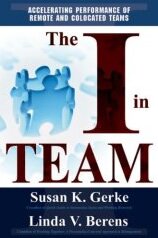Books
 The I in TEAM
The I in TEAM
Linda and I have teamed up again to write! See Collaborations Summer 2005 for a review. The book is available from www.radiancehouse. com.
Overview
Many say there is no I in Team. We say there is. The I stands for the individual. Teams are made up of individuals who are expected to work together in a way that produces more than they could produce working separately. Individuals bring their talents, goals, role expectations, working habits, and many other characteristics to the team. They don't suddenly become "we."
There is always a question of, "Do I have to give up me to work effectively on this team?" Effective teamwork always is a balancing act between independence and interdependence, between the individual and the group. Each individual has core psychological needs, values, and talents that are essential to their well-being and high performance. Each person is unique, yet each has many things in common with others.
Using the framework of the stages of team development (forming, storming, norming and performing), we have identified how people of each of four temperament patterns are likely to experience each of the stages. The storming chapter explores the many conflicts teams experience that are temperament related. We identify them and then provide suggestions on how to deal with those conflicts. We share tips on what the leader should be doing at each stage to help the individuals and the team grow.
The topic of remote teams overlays the whole book. There are many similar dynamics in team development whether the team members are remote or colocated. However, we call out those situations where remote teams will have different or more extreme issues or concerns.
What People Are Saying About the Book
Patrick Lencioni - President, The Table Group
Author, The Five Dysfunctions of a Team
"Understanding the various preferences and temperaments of team members is one of the critical steps to building a cohesive and effective team. The I in TEAM is a fabulous tool for consultants or managers trying to help groups of individuals who want to accomplish more working together than they can working apart."
Missy Anderson - CEO, OnCourse Promotions
"The I in TEAM was one of those books that not only do you read twice but use it as a reference manual as your business grows. Susan and Linda seem to understand the heart of any business and its people and they know how to keep the blood pumping."
David Specht - President, Performance Point
Author, Lessons from the Window Seat: Achieving Shared Vision in the Workplace
"Following the checklists prsented in The I in TEAM will increase buy-in and consistently allow meeting participants to embrace the diversity of thought necessary to determine the best course of action. Facilitating strategic initiatives for my clients will be 50% easier using the tables in this book."
Deborah Santana - COO, Santana Band, VP, Milagro Foundation
Author, Space Between the Stars
"The I in TEAM promises to stimulate and improve workplace communication with integrity, and lead any staff to congruent teamwork by teaching how to work with differences in style and temperaments. This is a model to reach the highest success for companies!"
Susan Nash - Author, Turning Team Performance Inside Out: Team Types and Temperament for High-Impact Results
"Susan and Linda have created an excellent model integrating how to use the richness of temperament theory in building a team's performance through the various stages of team development. This book will provide team leaders with a unique insight into improving team productivity by capitalizing on individual needs, talents, and behaviors."
Henry Martinez - Vice President Engineering, Vision Solutions, Inc.
"All managers who are going to lead a team through a cultural remodeling project ought to have this book in the top drawer of their toolbox. I particularly liked the book's visuals within the text - they kept both sides of my brain fully engaged."
 The Quick Guide to Interaction Styles and Working Remotely
The Quick Guide to Interaction Styles and Working Remotely
Now available at www.radiancehouse. com.
Overview
When working remotely (in different offices, on different floors, at home, etc.), we can't see the body language or facial expressions of those with whom we are communicating. We also can't count on informal interactions as a means to get to know remote people in the way we can get to know those who are co-located with us. The Quick Guide to Interaction Styles and Working Remotely helps people in organizations work together more effectively when they aren't co-located.
Successful remote leaders and workers have learned that relationship building and understanding the styles of those they work with are keys to working remotely. Our pace of interactions varies as does the language we use to communicate. This booklet can be used to help you understand others better and then use that understanding to:
- build good working relationships
- effectively empower people
- set clear objectives
- give useful feedback and evaluations
Whether you are a leader trying to measure the performance of remote workers or a team member trying to figure out how to get teammates to help you complete a project, this guide is full of tips and approaches for working remotely.
&nbs p;
What People Are Saying About the Book
Review by Dave Carey - Speaker, Consultant, Coach
Author, The Ways We Choose
The Quick Guide to Interaction Styles and Working Remotely: Strategies for Leading and Working in Virtual Teams by Susan Gerke and Linda Berens is a straight forward, no-nonsense guide to thinking about one's own, or another's, preferential Interaction Style. The book's strength is in connecting Interaction Style to leadership, management, or membership in teams or groups which are not physically co-located.
Three aspects of this work are of particularly high value and great interest. The first is that the authors have strategically embedded throughout the booklet brief exercises and thought provoking questions, along with the space to respond to them. Thus the reader is encouraged to actively apply the information presented to their own personal situation.
Second is the application of the information presented to teams and work groups that are not geographically collocated. The demand for leaders, managers and team members to work effectively while being separated by buildings, time zones, and often countries or continents continues to grow as the twenty-first century progresses. The authors have a wealth of experience in these "virtual" arenas and share those experiences throughout the book.
The third aspect is the wide variety of very practical suggestions for increasing the effectiveness of "virtual teams." These tips cover a wide range of topics from trust building, performance appraisal and feedback, to effective uses of e-mail, instant messaging, voice mail, etc.
If more effective team leadership is your objective this will be a very worthwhile book.
Beverly Kaye - Founder, CEO, Career Systems International
Author, Up Is Not the Only Way: A Guide to Developing Workforce Talent
"In a brilliantly simple and straighforward way, Susan and Linda give us the secrets of working together remotely. They answer an obvious but often ignored question for today's workforce. 'How in the world do we work together if we never (or almost never) get to see each other.' Bravo and thank you. A must for any remote team manager.
Richard K. Warren - IBM VP & Senior Location Executive, International Business Machines
"Thank you for an insightful consolidation of ideas on one of the industries significant challenges of this decade. You have begun to bring focus to a topic that affects us all as we continue to strive to make our new workforce more effective."
Randy Mysliviec - President, Telecom Solutions Group, Convergys
"This book will quickly help any business leader more effectively manage people in today's dynamic virtual work environment. Finally we have a simple guide to help us understand how to adapt our behaviors to get the most out of people and truly unlock the power of virtual work teams."
Brian Robertson - President & CEO, Ternary Software, Inc.
"A deeply insightful look at the challenges of working remotely, and a powerful practical tool for improving productivity of remotre workgroups!"
Richard Kam - President, Lascaux, LLC
"Communication and trust was rapidly declining and our remote management team was becoming ineffective. The information in this quick guide helped us understand why we were struggling to work as a virtual team. It helped us understand how to improve communication and rebuild trust. It is a valuable tool for anyone who leads or works in a virtual team."
David Hutchens
Author, Outlearning the Wolves: Surviving and Thriving in a Learning Organization
"I read this smart resource on a short flight between locations in my remote world. In my next cell-phone discussions with distant colleagues, I was already adopting my interaction styles in effective ways. I can't think of a higher compliment I could offer to the authors!"
Karen L. Hendricks - Trustee, Board of Directors, The Ohio State University
"This book could not have come at a better time. Managers at all levels would benefit greatly from these down-to-earth observations, tools, and techniques unique in addressing relationships, style, performance, and results with others who work remotely."
 Quick Guide to Interaction Styles and Time Dynamics
Quick Guide to Interaction Styles and Time Dynamics
I've written my third book! See Collaborations Summer 2007 for a review. The book is available from www.radiancehouse. com.
I have co-authored Quick Guide to Interaction Styles and Time Dynamics with Karon West - my long time friend and colleague.
This guide is designed to help people understand their relationship with time and to identify ways to use time more effectively. Our model looks at time in terms of:
- Time in relation to people (Interaction Styles)
- Time Boundaries
- Priorities
- Informed Choices
A "time" workshop is also available! Choose either ½ day or a full day workshop to help people determine how they can use new tools to be more time effective! Call or e-mail Susan for more information!
Overview
The Quick Guide to Interaction Styles and Time Dynamics helps people learn to make good choices about how to use time more efficiently and effectively. This guide identifies four time dynamics that when understood, provide clarity on how we each relate to time. The dynamics are: time in relation to people, time boundaries, priorities, and informed choices. Tools, tips and techniques are provided for you for each dynamic. As you explore, you will be able to select the time tools that will be most useful for you in your life.
Time in relation to people explores four time styles and identifies the time strengths and challenges of each style. Time boundaries identifies specific areas where you can manage time boundaries better. The priorities dynamic provides a variety of ways to focus on what's most important. And finally, informed choices helps you look at how you can better take control of your time. Though not all approaches to managing time work for everyone, in this booklet you will clarify your relationship with time and gain insight about how others deal with time.
What People Are Saying About the Book
Cherry McPherson - President McPherson Wittemann and co-author of Inspiration or Desperation: Companies Change When People Can
"This guide lives up to its promises - it's quick to read and full of gems. Make the most of your time with the fresh ideas and novel tools you'll discover. Then learn how to work more effectively with others who have different time orientations."
Monica Olsen - President, Olsen & Associates Consulting
"Just when you thought you have read all the time management books, along comes "Quick Guide" that actually takes this topic to a deeper dimension. Learn how your particular Interaction Style & the styles of those you live and work with, use and misuse time, set boundaries, make priorities and ultimately become energized or stressed. Don't waste a precious minute - read the book and I guarantee you that there is a captivating "aha" for you just waiting to be discovered."
Michael Vantrease - Senior Vice President, Learning and Development Manager, Bank of the West
"This book incorporates a wonderful blend of practical approaches to managing one's time more effectively, while looking at the connection between our Interaction Styles and time management behaviors. The tool boxes provide valuable ideas that the reader can quickly review and put into action."
Connie Phillips - Manager, Organization Development & Leadership, City of Anaheim, CA
"First choice for a quick overview of proven time management tools and techniques. The authors stand out from other writers in this area by linking time management and Interaction Styles. Useful for support staff and senior managers."
Moira Bell - Organizational Development Consultant
"Thought provoking practical guide with invaluable tips for getting the most out of how you choose to spend your time."
David West - Manager, Operation Systems Analysis, Alliance Atlantis Communications
"Quick Guide to Interaction Styles and Time Dynamics is an invaluable tool in today's hectic business world."
Cheri Sherman - Director and Co-Founder, Leadership Services Program, Chapman University
"Time management continues to be a critical topic to leaders at every level of an organization. The Quick Guide to Interaction Styles and Time Dynamics offers a unique and powerful approach to managing time through the lens of Interaction Styles."